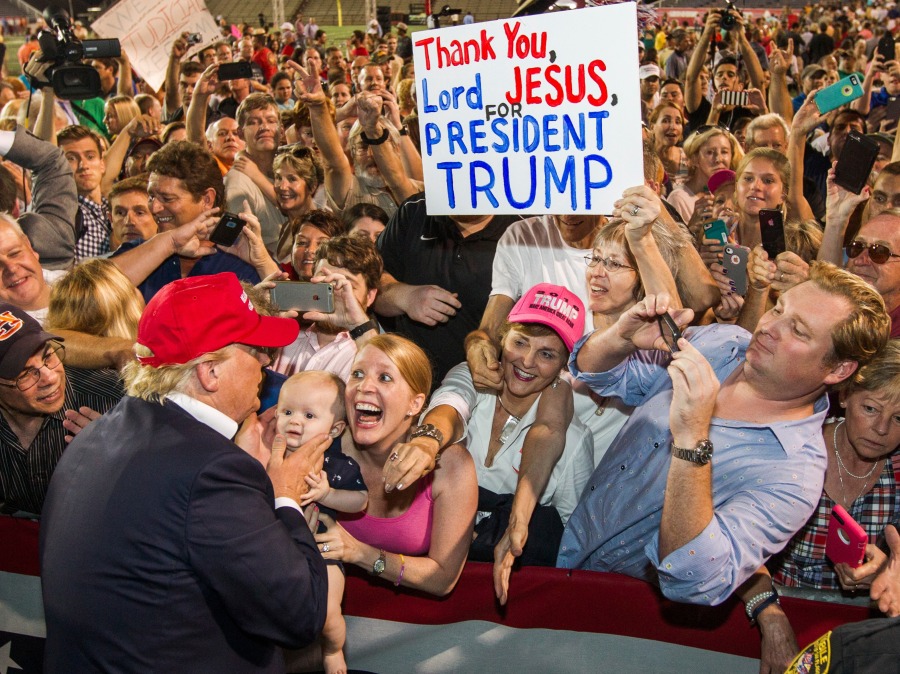In Campaign Craft: The Strategies, Tactics, and Art of Political Campaign Management, 4th edition, edited by Shea and Burton, what the voters want, what the candidate has to offer, and what the opponent brings to the table are all discussed as important elements to a political campaign (loc. 1567). Trump seems to run his campaign in opposition to simply everything, but he does care about what voters want, he does care about what he has to offer, and he does pay attention to what his opponents bring to the table. Although his campaign is a bull charging straight ahead, the focus on voter mobilization and what they want and need to be mobilized, his unique set of skills and ways to get that goal accomplished, and his laser focus on his opponents mistakes – which is the only thing they bring to the table in Trump’s eyes – all show that Trump does embody these particular campaign elements in his quest to become president of the United States.
Trump is basing his campaign on mobilization rather than persuasion or reinforcement. A mobilization campaign recognizes that “many fairly reliable supporters need to be motivated to actually cast a vote” (Shea and Burton loc. 1015), while a persuasion campaign aims to “bring swing voters onto the candidate’s side” (Shea and Burton loc. 1015). Trump has a support group that gravitates to his brash political style, but “turnout is key” (Shea and Burton loc. 1015). According to Kenneth P. Vogel and Darren Samuelson in the article “How Trump Let Himself Get Out-Organized,” Trump has won over “nontraditional Republican voters” (1), and now his only job is to get them to actually go and vote. According to Jordan Gherke in his National Review article “Can Trump Win With New Voters?,” Donald Trump has a “knack for reaching voters who don’t normally go to the polls” (1), but it not necessarily a lock that it will happen. Trump has to put effort into mobilizing his unique support base. Trump needs “every guy in Iowa and New Hampshire with a gun rack on his truck and a subscription to Juggs magazine to go vote” (Gherke 1). Trump has to win by focusing on supporter turnout, and this is called a “base mobilization strategy” (Shea and Burton loc. 1015).
Trump has two things to offer to his base that he is trying to motivate. The two ways that he can try and motivate them are through his star power and through his positioning relative to his opponents. Trump is relying on his star power to motivate voter turnout. Trump, prior to Iowa, barely spent any money on voter mobilization (Vogel 1), and instead “his star power would provide a new way to mobilize voters” (Vogel 1). The way Trump uses his star power is to make use of the cue-taking voters described by Stephen C. Craig and Michael D. Martinez in The Electoral Challenge: Theory Meets Practice, 2nd edition, edited by Craig and Hill, really attach onto the cues that he gives. Cues are talking points given by a candidate that are “substitutes for actual knowledge to the extent that they are relatively accurate, relevant, and available to those who need them the most” (Craig and Hill 80). Trump viciously attacks people who the right cue-taking voters will see as a threat, including minorities, women, the media, and his opponents.
Trump’s opponents seem to bring to the table one single theme at this stage in the primaries: anyone but Trump. Shea and Burton argue that a candidate’s position with respect to individual voters is given form by the themes that it represents, and Trump’s polarizing nature sets the theme for his opponents and also Trump’s campaign itself by being in opposition to them. In an early debate, Trump denied to support the GOP nominee if it did not end up being him, thereby setting the stage for a campaign that set its theme as contrary to anything and everyone. What Trump’s candidates bring to the table, is seemingly target practice for Donald Trump.
Trump’s brash nature is used to target voters, mobilize them, show off Trump’s natural abilities, and bring down his opponents. Trump uses focus on voter mobilization and what they want and need to be mobilized, his unique set of skills and ways to get that goal accomplished, and his laser focus on his opponents mistakes to blaze what he certainly hopes is a trail straight to the office of the president.
Works Cited
Craig and Hill. The Electoral Challenge: Theory Meets Practice, 2nd edition. CQ Press, 2011.
Gherke, Jordan. “Can Trump Win with New Voters?” National Review. 17 Dec. 2015. Web. 10 Feb. 2016.
Shea and Burton. Campaign Craft: The Strategies, Tactics, and Art of Political Campaign Management, 4th edition. Praeger, 2010.
Vogel, Kenneth P., and Darren Samuelson. “How Trump Let Himself Get Out-Organized.” Politico. 2 Feb. 16. Web. 23 Feb. 2016.
